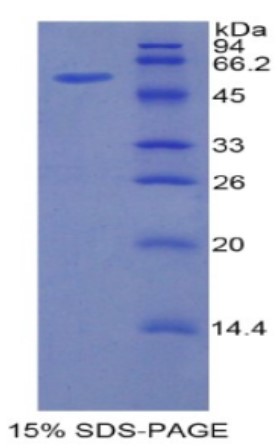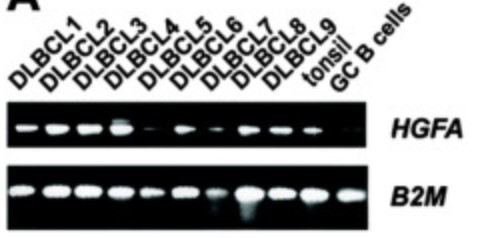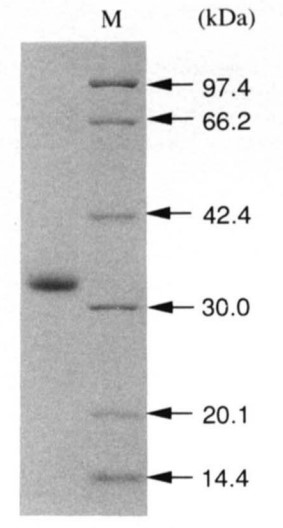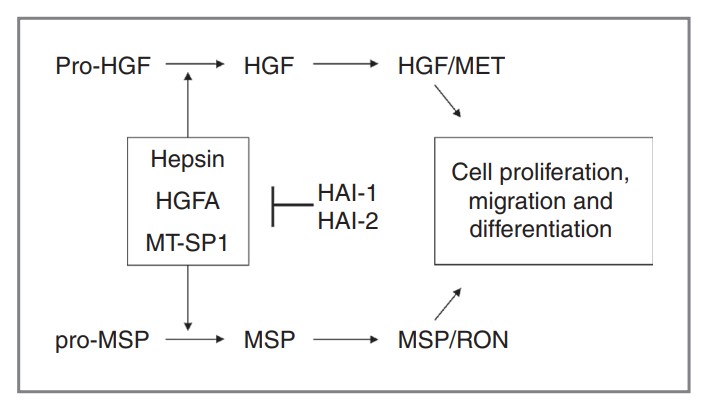HGFAC
-
Official Full Name
HGF Activator
-
Overview
The protein encoded by this gene belongs to peptidase family S1. It is first synthesized as an inactive single-chain precursor before being activated to a heterodimeric form by endoproteolytic processing. It acts as serine protease that converts hepatocyte growth factor to the active form. -
Synonyms
HGFAC; HGF activator; HGFA; MGC138395; MGC138397; EC 3.4.21.; Hepatocyte growth factor activator; Hepatocyte growth factor activator short chain; Hepatocyte growth factor activator long chain;
- Recombinant Proteins
- Cell & Tissue Lysates
- Human
- Mouse
- Rat
- Zebrafish
- E.coli
- HEK293
- Human Cell
- Mammalian Cell
- His
- His|GST
- N/A
- N
| Species | Cat.# | Product name | Source (Host) | Tag | Protein Length | Price |
|---|---|---|---|---|---|---|
| Human | HGFAC-488H | Recombinant Human HGFAC, His tagged | HEK293 | His | Met 1-Ser 655 | |
| Human | HGFA-2940HCL | Recombinant Human HGFA cell lysate | Human Cell | N/A |
|
|
| Human | HGFAC-2237H | Recombinant Human HGFAC Protein, His-tagged | E.coli | N-His | Asn340-Gln595 |
|
| Mouse | Hgfac-1594M | Recombinant Mouse Hgfac protein, His & GST-tagged | E.coli | His/GST | Pro104~Asp351 (Accession # Q9R098) |
|
| Rat | Hgfac-1595R | Recombinant Rat Hgfac protein, His & GST-tagged | E.coli | His/GST | Ala363~Arg622 (Accession # Q5EBA7) |
|
| Zebrafish | HGFA-2081Z | Recombinant Zebrafish HGFA | Mammalian Cell | His |
|
- Background
- Quality Guarantee
- Case Study
- HGFAC Related Articles
- HGFAC Related Research Area
What is HGFAC protein?
HGFAC (HGF activator ) gene is a protein coding gene which situated on the short arm of chromosome 4 at locus 4p16. This gene encodes a member of the peptidase S1 protein family called HGFAC or HGFA. The encoded protein is first synthesized as an inactive single-chain precursor before being activated to a heterodimeric form by endoproteolytic processing. It acts as serine protease that converts hepatocyte growth factor to the active form. The HGFAC protein is consisted of 655 amino acids and its molecular mass is approximately 70.7 kDa.
What is the function of HGFAC protein?
HGF activator (HGFA) is an enzyme whose function is to activate hepatocyte growth factor (HGF). Specifically, HGFA can shear the HGF precursor protein (pre-HGF) into the active form of HGF. Active HGF binds to its receptor, c-Met, and promotes cell proliferation, survival, migration, and differentiation. Therefore, HGFA plays an important role in regulating physiological and pathological processes such as cell growth, tissue repair, and cancer progression.
HGFAC Related Signaling Pathway
HGFA is an HGF/SF precursor protein cutting enzyme that can cut HGF/SF precursor proteins into mature HGF/SF, thereby activating the HGF/SF signaling pathway. In addition, HGFA can activate ERK signaling pathway and PI3K/Akt signaling pathway, while inhibiting TGF-β signaling pathway and Wnt/β-catenin signaling pathway, thereby conditioning cell proliferation, survival and other activities.
HGFAC Related Diseases
Diseases associated with HGFAC include deafness and diarrhea with tufting enteropathy. High levels of HGFA expression are associated with tumor invasion and metastasis, including liver cancer, colorectal cancer, breast cancer, etc., and abnormal HGFA activation is associated with inflammatory diseases. In addition, abnormal HGFA function may lead to abnormal activation or suppression of the immune system, which affects the body's immune response to infections and tumors.
Bioapplications of HGFAC
HGFA has been applied in the medical field, and the targeted therapy for HGFA has become a new strategy for cancer treatment.
High Purity

Fig1. SDS-PAGE (HGFAC-2237H) (PROTOCOL for western blot)
.

Fig2. SDS-PAGE (Hgfac-1594M) (PROTOCOL for western blot)
Case Study 1: Esther P M Tjin, 2006

Fig1. Expression of HGFA in GC B cells and primary DLBCLs at mRNA level.
Case Study 2: K Miyazawa, 1993

Fig2. SDS-PAGE of purified human HGF activator.

Fig2. Model of protease/inhibitor system regulating growth factor signaling. (Rajkumar Ganesan, 2011)
HGFAC involved in several pathways and played different roles in them. We selected most pathways HGFAC participated on our site, such as , which may be useful for your reference. Also, other proteins which involved in the same pathway with HGFAC were listed below. Creative BioMart supplied nearly all the proteins listed, you can search them on our site.
| Pathway Name | Pathway Related Protein |
|---|
HGFAC has several biochemical functions, for example, . Some of the functions are cooperated with other proteins, some of the functions could acted by HGFAC itself. We selected most functions HGFAC had, and list some proteins which have the same functions with HGFAC. You can find most of the proteins on our site.
| Function | Related Protein |
|---|
HGFAC has direct interactions with proteins and molecules. Those interactions were detected by several methods such as yeast two hybrid, co-IP, pull-down and so on. We selected proteins and molecules interacted with HGFAC here. Most of them are supplied by our site. Hope this information will be useful for your research of HGFAC.
- Q&As
- Reviews
Q&As (7)
Ask a questionThere are currently no approved drugs specifically targeting HGFAC that are widely available. However, several new drugs targeting HGFAC are under early-stage research and clinical trials. These drugs aim to inhibit the biological activity of HGFAC or restore it to normal levels for the treatment of various diseases.
HGFAC, as a biomarker, can be applied in the diagnosis and therapeutic monitoring of many diseases. For example, HGFAC levels can serve as a tumor marker in the diagnosis and assessment of treatment efficacy in diseases such as liver cancer, pancreatic cancer, and colorectal cancer. Furthermore, in diseases like kidney disease and primary sclerosing cholangitis, HGFAC levels are considered biomarkers of diagnostic and therapeutic monitoring significance.
HGFAC functions as a protease and its activation of HGF involves proteolytic cleavage and binding between different domains of HGF. The proteolytic action of HGFAC induces structural changes in the HGF molecule, leading to its interaction with the c-Met receptor and subsequent activation of downstream signaling pathways.
The activation and inhibition of HGFAC can have different effects on human health. In terms of tissue repair and regeneration, HGFAC activation is crucial for the proper functioning of the HGF signaling pathway, making it important for the treatment of tissue injuries and diseases. However, dysregulated HGFAC activation has pathological implications in diseases like cancer and fibrosis. Inhibiting HGFAC may have potential therapeutic effects, suppressing disease progression and alleviating symptoms.
HGFAC, also known as Hepatocyte Growth Factor Activator, plays a crucial role in the activation of hepatocyte growth factor (HGF). Its dysregulation has been implicated in various diseases such as cancer, liver disease, and kidney disease. In liver and pancreatic cancer, HGFAC promotes tumor proliferation and angiogenesis. Excessive activation of HGFAC can also lead to hepatocyte apoptosis and liver fibrosis. Additionally, elevated plasma levels of HGFAC have been associated with hypertension, stroke, glucose instability, and metabolic syndrome.
Dysregulation of HGFAC has been associated with various diseases and pathological conditions. For example, overexpression of HGFAC has been linked to the progression of certain cancers, as it can enhance cell proliferation, migration, and invasiveness. On the other hand, decreased expression or mutations in HGFAC have been associated with impaired tissue regeneration and wound healing. Understanding the dysregulation of HGFAC may contribute to the development of targeted therapies for these diseases.
Recent research advances have highlighted HGFAC as a potential target for treating various diseases. Drugs targeting the HGF/c-Met signaling pathway have garnered significant interest, with some targeted therapies entering clinical research. However, the development of drugs targeting HGFAC still faces challenges such as lack of specificity and efficacy, as well as the need for a better understanding of long-term safety profiles.
Customer Reviews (3)
Write a reviewUnlocking new possibilities, the innovation surrounding this experimental reagent surpasses previous research limitations.
Harnessing impeccable formulations, it epitomizes perfection in experimental outcomes.
The reagent of choice for enhancing reliability in experimentation.
Ask a Question for All HGFAC Products
Required fields are marked with *
My Review for All HGFAC Products
Required fields are marked with *


